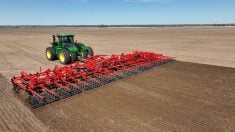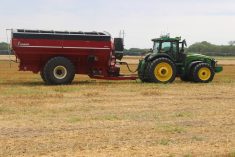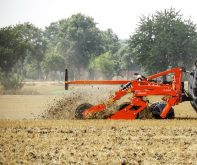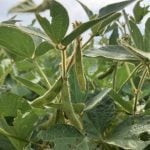While Mother Nature does its best in Western Canada to alleviate soil compaction through the freeze and thaw cycle, researchers suspect nature has a hard time keeping up with the pressure (figuratively and literally) of modern agricultural technology.
Bigger, heavier equipment travelling over fields, particularly when soil conditions are wet, is believed to cause soil compaction at various depths across an ever-increasing number of farmland acres.
That compacted layer ultimately has a negative effect on crop production.
Read Also

Claas brings 1000 Series SP forage harvesters to Canada
In mid-August, Claas unveiled its new line of Jaguar forage harvesters at an event in Visalia, California, deep in the heart of that state’s dairy region.
Prairie farmers contacted for this farmer panel are aware of the risk of soil compaction. Some are assessing what it might mean for their farms while others have already made changes in production practices to break up that hardpan layer and keep soils productive.
Here is what farmer panel members had to say about recognizing and managing soil compaction.
Eric Fridfinnson
Arborg, Man.

Longtime Arborg-area farmer Eric Fridfinnson is winding down operations as he plans retirement, but for the past five years he has used a tillage tool to break up compacted soil in high-traffic areas on his cropland.
Fridfinnson sold most equipment earlier this year and had about 500 acres of canola and alfalfa seed to harvest this fall. About five years ago, he bought an Unverferth tillage tool to break up a plow pan layer.
It was a 20-foot-wide toolbar with coulters in front to break the soil ahead of narrow, 30-inch long shanks with a narrow shoe on the bottom. He pulled it with a front wheel assist tractor. He wanted a tool that was low disturbance and didn’t require another pass to smooth out the field.
“We were noticing in the high-traffic areas, like the entrance to fields and other areas where there was more traffic with the combine or grain carts, that those areas were producing less, and as you moved out farther in the field, yields improved,” says Fridfinnson, who farms in the Interlake region about 100 kilometres north of Winnipeg.
He suspected compaction and checked research from the University of Minnesota. He also bought a penetrometer to measure soil density. It is a hand-held metal probe, with a pressure gauge at the top that is pushed into the soil. Easy pushing usually stops when it hits a compacted level.
“So, we used the penetrometer to identify areas of the field with compacted soil,” says Fridfinnson. “And then we went in and made a pass with the tillage tool to break up the compacted layer.
“We have been direct seeding with zero tillage since the 1980s. Using the penetrometer, we found in the high-traffic areas there was a compacted layer about eight inches down.”

Following the advice of researchers, he ran the shanks only deep enough to break up the compacted layer. The recommendation was, for example, if compaction was three inches deep, stick to three inches and don’t run the shank any deeper.
“It was remarkable how well it worked,” says Fridfinnson. “We would treat those high-traffic areas in the fall and then seed through them the next year and crop yields would be as good as the rest of the field.”
As a longtime forage seed grower, he says the tillage tool was effective, but he thinks the long-term solution is to grow alfalfa or other deep-rooted crops in rotation.
Scott Perkin
Elgin, Man.

In southwest Manitoba, Scott Perkin says the effect of soil compaction is something they think about on their family farm near Elgin, and they may take action later this year.
Perkin, who is part of the family-run, mixed farming operation and the owner of Perkin Seed and Soil, says nature can deal with compaction to some extent through freeze and thaw action, but the family wonders if more is needed.
“We have discussed using a subsoiler, but we’re not sure if it is necessary,” says Perkin. He hopes to get direction when his company hosts a soil scientist to speak at an upcoming customer appreciation day.
“I’d like to hear more about the pros and cons and make sure a subsoiler does provide a benefit,” he says. Perkin knows there are certain areas in a field that don’t produce much, and there are also areas of alkali soil.
“Provided there is enough moisture to get the tool in the ground, are there enough benefits? We need some direction on that.”
Andy Kirschenman
Hilda, Alta.
Andy Kirschenman farms with family members in southeastern Alberta. He says they are aware of the risk of soil compaction but aren’t sure how big an issue it is on their farm.

Kirschenman, who owns and operates Harvest Moon Farms along with his wife and parents, says the farm has experienced several years of extremely dry growing conditions. Crop production is obviously affected by drought, but they haven’t seen specific production issues they can attribute to soil compaction.
“We have some pretty sandy soils on part of the farm and compaction might be more of an issue if we had wet conditions, but we haven’t had that problem for several years,” he says. “We’ve had some pretty dry years, so I’m not sure if compaction is something we need to deal with.”
Kirschenman hopes that growing drought-tolerant species will reduce the risk of soil compaction. The farm grows cereals, pulse crops and sunflowers and canola some years. They leave as much crop residue as possible to conserve moisture and improve soil organic matter.
“We’re hoping the taproots of sunflowers, for example, will reach down looking for moisture and nutrients to help break up or prevent a compaction layer,” he says.
He has done intercropping with peas and mustard in the past and this coming year he is hoping to do some intercropping with peas and Polish canola.
“I have the canola seed, so I am hoping to give it a try. Canola has a taproot as well that will hopefully help to open the soil profile.”

Scott Keller
New Norway, Alta.

Over the past 10 years, Scott Keller has tried a few ways to deal with compacted soil on his central Alberta farm.
He rented an Agroplow deep ripping tool in 2014 and treated about 200 acres of cropland. That made a difference.
“We took some poor soil that was perhaps producing 20 bushels and now can produce 30 to 35 bushels per acre,” he says. “That’s quite an improvement.”
In 2015, he also converted his grain and oilseed production system to controlled traffic farming. It’s a system of farming where all field operations follow the same wheel tracks or tramlines across a field, leaving the crop zone and traffic lanes permanently separated. Keller established tramlines with 35-foot centres and all field equipment — air drill, field sprayer, combine and grain carts — have wheel spacing to use those tramlines.
This fall, now with his own Agroplow deep ripping tool, he plans to identify more areas in more fields affected by soil compaction, rip those areas and then re-establish the tramlines. Though his dad was one of the early adopters of zero-till farming in the early 1990s, soil compaction has been a long-standing problem, and Keller wants to deal with it.
“We’ve been using controlled traffic farming for a few years, and it is too bad we have to rip through those tramlines,” says Keller. “But we have some areas of very sandy soil and once it gets compacted, it doesn’t disappear on its own. You need to break it up. Once we return to controlled traffic farming, hopefully the compaction doesn’t return.”
Along with family members, Keller crops about 2,500 acres of grains, oilseeds and pulse crops near New Norway, about half an hour southwest of Camrose, Alta. He says the turning point came in 2014 when “we had one field of canola that looked like hell.”
At first, he thought it was a nutrient deficiency, but during a farm visit by a Canola Council of Canada agronomist, they dug up a few plants.
“The roots all went down about six inches and then they pancaked,” says Keller. “They hit a compacted layer of that sandy soil and went sideways.”
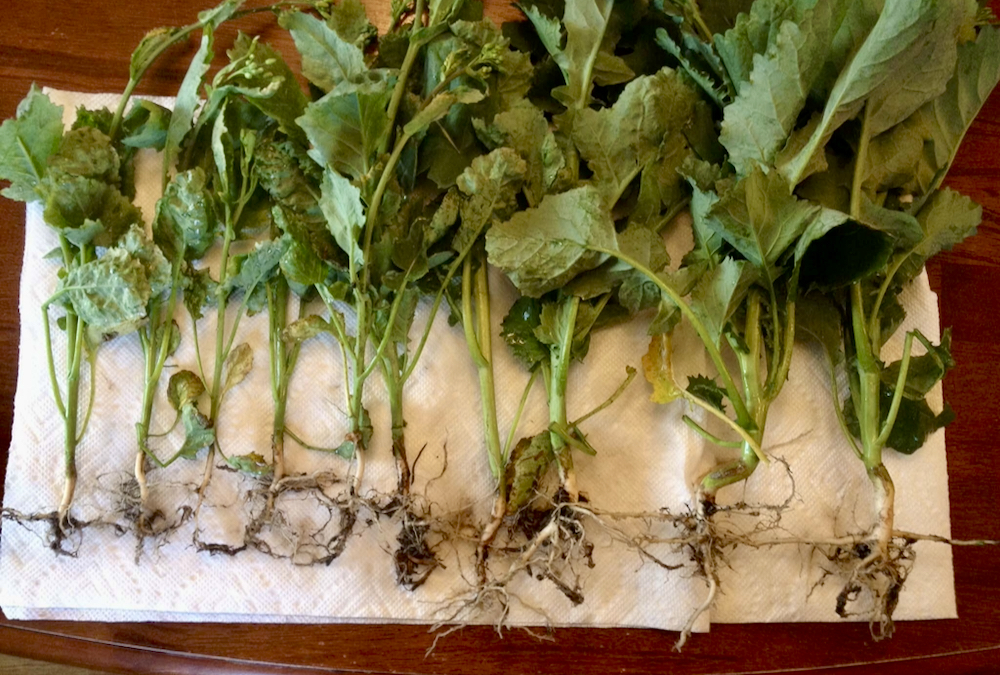
The soil was dry above the compacted layer, and when they dug through it, the sandy soil below was soaking wet. Using a penetrometer on different parts of the field, they were able to push it quite deep without trouble.
“Then I’d hit one of these compacted areas and it would just stop at the seven- to eight-inch mark,” says Keller. “I pushed so hard I even broke the spring on the gauge.”
Following the experience of Steve Larocque of Beyond Agronomy, an independent crop adviser who pioneered controlled traffic farming in Canada on his own farm, Keller set up his controlled traffic farming in 2015.
While it probably helped, Keller says, the full solution on sandy soils is to use tillage to break up the compacted layer and start fresh with controlled traffic farming. This past spring, he bought his own used Agroplow tool. It is 22 feet wide with 19 shanks and able to rip as much as two feet deep.
He doesn’t plan to run it that deep, however.
“I’ll use the penetrometer to figure out what areas of a field have compaction, most likely at the seven- or eight-inch depth, and then I’ll Agroplow those areas and re-establish the tramlines for the following seeding season.”

Deep ripping is a slow process. Even with a John Deere 9530, with about 500 horsepower, there is a bit of slip travelling at three miles per hour.
Keller isn’t sure how much of the farm will need to be treated. About 20 per cent of their land is sandy loam. He will use the penetrometer to identify areas with compaction.
Derek Axten
Minton, Sask.
Improved water infiltration on their south Saskatchewan farm is a good indication to Derek Axten that eight or more years of changes in farming practices, including adoption of controlled traffic farming, is reducing soil compaction and improving soil quality.

Axten farms with his wife, Tannis, and family members at Minton, about 20 km north of the Montana border. He says if someone had told him a few years ago that two inches of rain would disappear into the fields on his farm in a few minutes — without runoff — he wouldn’t have believed them.
The soil on their farm ranges from sandy to sandy clay loam, while organic matter can vary from one per cent on hilltops to 6.5 per cent in low-lying areas.
Axten says he knew there was a soil compaction problem on the farm. Going back to the early 2000s, for example, “on most fields, you’d have a few inches of loose topsoil and below that you’d run into this platey, plow pan layer that was two or three inches thick. It was hard, blocky soil, and it seemed to be worse during dry years.”
After attending a field day several years ago at Dakota Lakes Research Farm in South Dakota, Axten ran some water infiltration tests on his own farm. At best, one inch of water would disappear on some soils in four to five minutes, and on other areas he quit after waiting 10 minutes.
Now, after several years of controlled traffic farming and other changes, that one inch of water on most fields disappears in about 30 seconds and two inches of water, depending on the year and the field, disappears within two to five minutes.
“We’re not seeing those rates on every field or every acre, but we are seeing improved water infiltration rates over much more of the farm,” he says.
They don’t often get two inches of rain, but when it does come, regardless of how much, the goal is to have it soak in. They make a point to maintain a good layer of organic matter and mulch to help conserve moisture.

By attending field days and visiting other farms, Axten got a sense of what a healthy soil should look like, but he didn’t know how to achieve it. In both 2010 and 2011 he attended field days in Alberta on Steve Larocque’s farm north of Drumheller and learned about controlled traffic farming.
“They were putting shovels in the ground to demonstrate soil quality in areas of the field where there had been no machinery traffic,” says Axten. That sold him on the idea.
In 2015, he launched into controlled traffic farming on his farm. His system is set up on 30-foot tramlines with all equipment adapted to this spacing or multiples up to 120 feet. That wasn’t the only practice they adopted. They also grow cover crops and have applied intercropping on some fields to increase plant diversity.
Combines are equipped with stripper headers and straw choppers that distribute straw evenly over a 30-foot width, all of which helps keep as much residue as possible on the soil. They also make and apply compost, which has reduced the use of synthetic fertilizer by about 75 per cent.
“Controlled traffic farming has certainly helped, but I don’t know if there is any one thing that has made the difference, or perhaps it is a combination of all things,” he says.
“I know our soil quality has improved. It has been quite dry but when it does rain, the water goes down and doesn’t run off. We’re also seeing improved production. I’d say yields have increased by about 20 per cent — noticeably better yields.
“Our focus is to look after and enhance soil biology,” he says. “The soil is a biological system. It needs water and air to function properly. We apply a number of practices that minimize soil disturbance, keep the soil covered and keep the biology working.”





